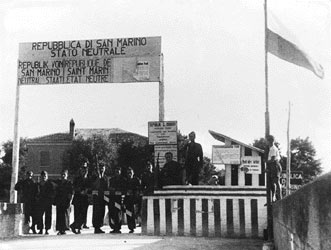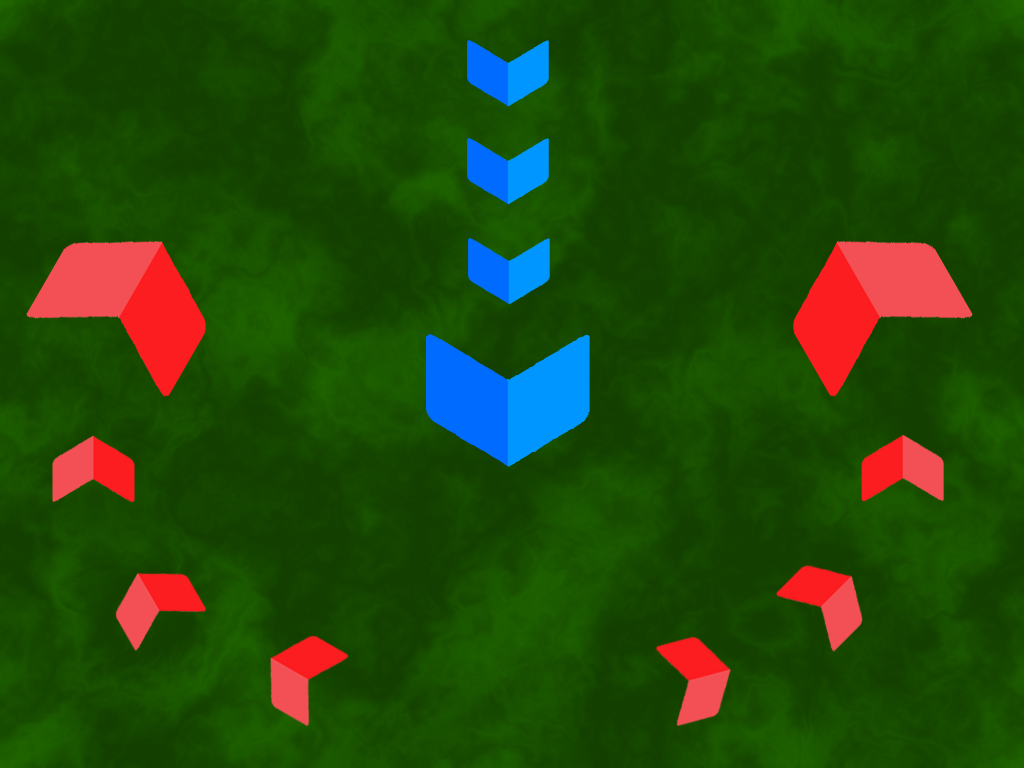|
San Marino In World War II
The Battle of San Marino was an engagement on 17–20 September 1944 during the Italian Campaign of the Second World War, in which German Army forces occupied the neutral Republic of San Marino, and were then attacked by Allied forces. It is also sometimes known as the Battle of Monte Pulito. San Marino had declared its neutrality earlier in the war, and had remained broadly unaffected by events in Europe until 1943, when Allied forces had advanced a sizable distance up the Italian Peninsula. A major German defensive position, the Gothic Line, ran across the peninsula a short distance south of the Sammarinese border, and in late June, the country was bombed by the Royal Air Force, killing 35 people, in the belief that the German Army had taken up positions on its territory. In Operation Olive, launched in late August, a strong Allied force attacked at the very eastern end of the line, aiming to pass through Rimini—just east of San Marino—and break out onto the plains north o ... [...More Info...] [...Related Items...] OR: [Wikipedia] [Google] [Baidu] |
Operation Olive
The Gothic Line (german: Gotenstellung; it, Linea Gotica) was a German defensive line of the Italian Campaign of World War II. It formed Field Marshal Albert Kesselring's last major line of defence along the summits of the northern part of the Apennine Mountains during the fighting retreat of the German forces in Italy against the Allied Armies in Italy, commanded by General Sir Harold Alexander. Adolf Hitler had concerns about the state of preparation of the Gothic Line: he feared the Allies would use amphibious landings to outflank its defences. To downgrade its importance in the eyes of both friend and foe, he ordered the name, with its historic connotations, changed, reasoning that if the Allies managed to break through they would not be able to use the more impressive name to magnify their victory claims. In response to this order, Kesselring renamed it the "Green Line" (''Grüne Linie'') in June 1944. Using more than 15,000 slave labourers, the Germans created more ... [...More Info...] [...Related Items...] OR: [Wikipedia] [Google] [Baidu] |
Microstate
A microstate or ministate is a sovereign state having a very small population or very small land area, usually both. However, the meanings of "state" and "very small" are not well-defined in international law.Warrington, E. (1994). "Lilliputs Revisited". ''Asian Journal of Public Administration'', 16(1). Some recent attempts to define microstates have focused on identifying qualitative features that are linked to their size and population, such as partial delegation of their sovereignty to larger states, such as for international defense. Commonly accepted examples of microstates include Andorra, Liechtenstein, Monaco, Nauru, Palau, San Marino and Tuvalu. The smallest political entity recognized as a sovereign state is Vatican City, with fewer than 1,000 residents and an area of only . Some microstates – such as Monaco and Vatican City – are city-states consisting of a single municipality. Definitions Quantitative Most scholars identify microstates by using a quanti ... [...More Info...] [...Related Items...] OR: [Wikipedia] [Google] [Baidu] |
Battle Of Gemmano
The Battle of Gemmano took place during World War II, between the dates of September 4th, and September 15th of 1944. The battle occurred in the area of the Gothic Line, near the Apennine Mountains in northern Italy, which would soon turn out to be the last line of defense for the Axis Powers in Italy. The village of Gemmano was eventually captured on September 9th, 1944 by the invading Eighth Army (United Kingdom), but two more subsequent attacks were needed to secure the area surrounding the village of Gemmano. Fighting was so fierce, similar to that of the famous battle of Monte Cassino, that the battle was sometimes referred to as, “ The Cassino of the Adriatic”. Order of battle Events Tactics and strategy Under Operation Olive, the objective for the British Eighth Army on the Adriatic Coast was to break the German defenses and enter the Po Plains. The US Fifth Army would then follow up with an attack north of Florence, completing the German defeat. The first assault ... [...More Info...] [...Related Items...] OR: [Wikipedia] [Google] [Baidu] |
Conca (river)
The Conca is a river in the Marche and Emilia-Romagna regions of Italy. Its source is Monte Carpegna, which is in the Montefeltro part of the province of Pesaro e Urbino. The river flows northeast near Macerata Feltria and Mercatino Conca before crossing into the province of Rimini. The river then flows past Morciano di Romagna before entering the Adriatic Sea southeast of Misano Adriatico and northwest of Cattolica. History During World War II, the British and their allies defeated the Germans in a battle near the Conca. The Conca was part of the German defenses known as the Gothic Line. This battle took place in 1944 and was known as Operation Olive The Gothic Line (german: Gotenstellung; it, Linea Gotica) was a German defensive line of the Italian Campaign of World War II. It formed Field Marshal Albert Kesselring's last major line of defence along the summits of the northern part of t .... References Rivers of the Province of Pesaro and Urbino Rivers of the Provin ... [...More Info...] [...Related Items...] OR: [Wikipedia] [Google] [Baidu] |
Pincer Movement
The pincer movement, or double envelopment, is a military maneuver in which forces simultaneously attack both flanks (sides) of an enemy formation. This classic maneuver holds an important foothold throughout the history of warfare. The pincer movement typically occurs when opposing forces advance towards the center of an army that responds by moving its outside forces to the enemy's flanks to surround it. At the same time, a second layer of pincers may attack the more distant flanks to keep reinforcements from the target units. Description A full pincer movement leads to the attacking army facing the enemy in front, on both flanks, and in the rear. If attacking pincers link up in the enemy's rear, the enemy is encircled. Such battles often end in surrendering or destroying the enemy force, but the encircled force can try to break out. They can attack the encirclement from the inside to escape, or a friendly external force can attack from the outside to open an escape rout ... [...More Info...] [...Related Items...] OR: [Wikipedia] [Google] [Baidu] |
United States Army North
The United States Army North (ARNORTH) is a formation of the United States Army. An Army Service Component Command (ASCC) subordinate to United States Northern Command (NORTHCOM), ARNORTH is the joint force land component of NORTHCOM.U.S. Army North (15 May 2020) Joint Forces Land Component Command JFLCC component of NORTHCOM ARNORTH is responsible for homeland defense and defense support of civil authorities. ARNORTH is garrisoned at , . Redesignated ARNORTH in 2004, it was first activated in earl ... [...More Info...] [...Related Items...] OR: [Wikipedia] [Google] [Baidu] |
Bologna
Bologna (, , ; egl, label= Emilian, Bulåggna ; lat, Bononia) is the capital and largest city of the Emilia-Romagna region in Northern Italy. It is the seventh most populous city in Italy with about 400,000 inhabitants and 150 different nationalities. Its metropolitan area is home to more than 1,000,000 people. It is known as the Fat City for its rich cuisine, and the Red City for its Spanish-style red tiled rooftops and, more recently, its leftist politics. It is also called the Learned City because it is home to the oldest university in the world. Originally Etruscan, the city has been an important urban center for centuries, first under the Etruscans (who called it ''Felsina''), then under the Celts as ''Bona'', later under the Romans (''Bonōnia''), then again in the Middle Ages, as a free municipality and later ''signoria'', when it was among the largest European cities by population. Famous for its towers, churches and lengthy porticoes, Bologna has a well-preserved ... [...More Info...] [...Related Items...] OR: [Wikipedia] [Google] [Baidu] |
Eighth Army (United Kingdom)
The Eighth Army was an Allied field army formation of the British Army during the Second World War, fighting in the North African and Italian campaigns. Units came from Australia, British India, Canada, Czechoslovakia, Free French Forces, Greece, New Zealand, Poland, Rhodesia, South Africa and the United Kingdom. Significant formations which passed through the Army included V Corps, X Corps, XIII Corps, XXX Corps, I Canadian Corps and the II Polish Corps. History North Africa The Eighth Army first went into action as an Army as part of Operation Crusader, the Allied operation to relieve the besieged city of Tobruk, on 17 November 1941, when it crossed the Egyptian frontier into Libya to attack Erwin Rommel's Panzer Army Africa. On 26 November the Commander-in-Chief Middle East Command, General Claude Auchinleck, replaced Cunningham with Major-General Neil Ritchie, following disagreements between Auchinleck and Cunningham. Despite achieving a number of tactical su ... [...More Info...] [...Related Items...] OR: [Wikipedia] [Google] [Baidu] |
Italian Social Republic
The Italian Social Republic ( it, Repubblica Sociale Italiana, ; RSI), known as the National Republican State of Italy ( it, Stato Nazionale Repubblicano d'Italia, SNRI) prior to December 1943 but more popularly known as the Republic of Salò ( it, Repubblica di Salò ), was a German puppet state with limited diplomatic recognition which was created during the later part of World War II, that existed from the beginning of the German occupation of Italy in September 1943 until the surrender of German troops in Italy in May 1945. The German occupation regime provoked widespread national resistance, leading to the Italian Civil War. The Italian Social Republic was the second and final incarnation of the Italian Fascist state, oficially led by Benito Mussolini and his reformed anti-monarchist Republican Fascist Party. The newly-founded state declared Rome its capital but was ''de facto'' centred on Salò (hence its colloquial name), a small town on Lake Garda, near Brescia ... [...More Info...] [...Related Items...] OR: [Wikipedia] [Google] [Baidu] |





